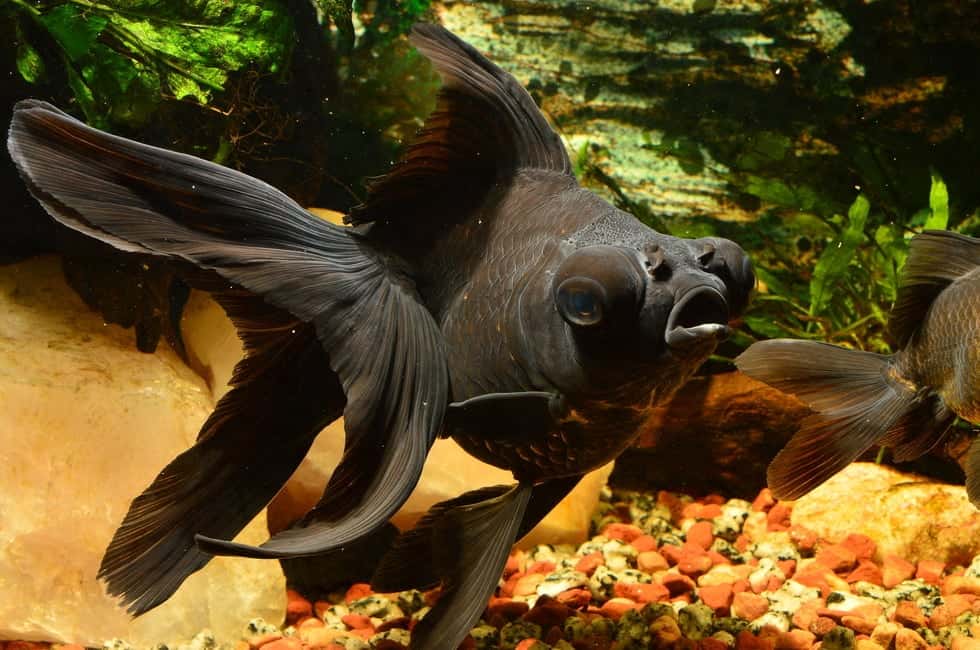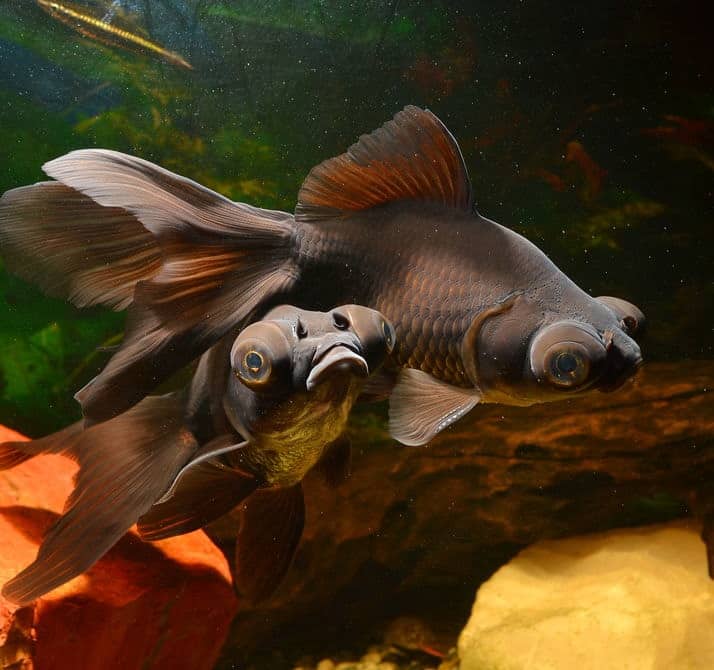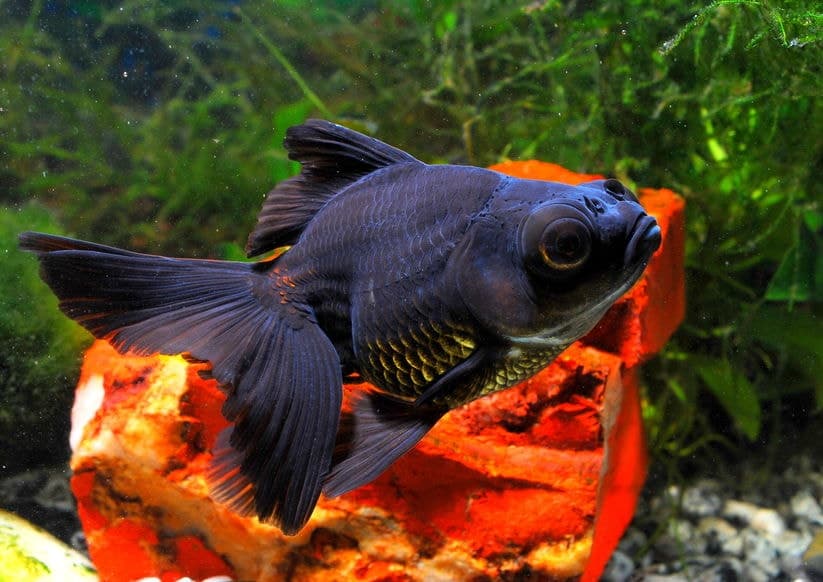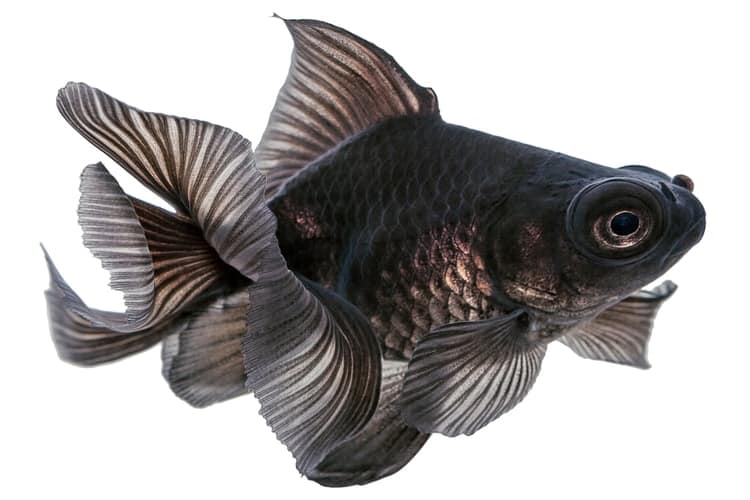Ready for an adventure into the world of one of the most distinct goldfishes in existence? This article would provide in-depth knowledge about the world of the black moor goldfish.
Known for their very distinctive black color, metallic scales, and bulgy eyes, the black moor goldfish is definitely hard to miss in a fish tank; these distinct qualities and also their friendly nature makes it hard not to love them!
The intense, rich dark color is because the black moor goldfish is very rich in melanin pigment. They are round shaped, with a short, stout body, beautiful twin tails, and very long fins.
Their bulgy eyeballs; which starts developing at about 3 to 4 weeks and is completely developed by 6 weeks, has a variety of shapes which could either be rounded, segmental or conical. Their eyes move to the sides and not upwards.
An immature black moor goldfish is initially amber colored, but as it grows older, the amber color begins to change to a distinctive overall black color.
Another phenomenon which occurs while the black moor goldfish is maturing is known as telescoping, this is when the initially flat eyes start to protrude from the sockets, both eyes are now similar to two telescopes.
Black Moor Goldfish Lifespan
If properly taken care of in an optimum, stress-free environment, your black moor goldfish can live for up to 15 or even 20 years.
Size
Their average length is about 4 inches, although there have been reports of some black moor goldfishes growing as long as 10 inches!
Ideal Temperature
They are called hardy freshwater fishes because they can survive even in cold water, as long as the drop in temperature is by only a few degrees each day.
They thrive in temperatures between 18 to 22 degrees Celsius (65 to 72 degrees Fahrenheit). Once the temperature increase above 72 degrees Fahrenheit, it means that the quantity of dissolved oxygen in the tank is lowered.
As cold water fishes, your black moor goldfish require sufficient quantities of oxygen, this would stress them and might result in the loss of their color known as demelanization, and if prolonged, might eventually result in premature death.
A sudden drop in temperature is likely to result in the premature death of your goldfish. So it is advisable that you get a heater that that can help maintain a constant temperature, thus, a stress-free environment for your black moor goldfish.
More: Do Goldfish Need a Heater in Winter
Ph Level
They thrive well when the ph in the tank is between 6.5 to 7.5, any sudden change in the ph would stress them.
Black Moor Goldfish Food
Due to their poor vision, it would be difficult for them to find their food if they are fed with pellets that float on the water, so it is advisable to give them pellets that sink, as that would not be a problem since they like digging.
You have to properly ration their meals so that they are not overfed as they have a voracious appetite and would eat virtually anything you feed them at any chance they get.
They are omnivorous, that is, they enjoy both plants and animal feeds. Their diet should include goldfish flakes or pellets
The plant feeds they enjoy include algae, vegetables such as broccoli, cucumbers, spinach, and peas (if you would feed them peas, ensure that the shells have been removed)
Feeds that could be live or frozen include Bloodworm, brine shrimp, sludge worm and daphnia. A major disadvantage of feeding them live feed is that some live feed could harbor the parasites or protozoa that might cause diseases in the black moor goldfish, so it is advisable to feed your goldfish freeze-dried foods.
It would make digestion quicker if these food particles are cut into tiny bits so that they can easily be digested since the goldfish has no stomach.
Although, the absence of a stomach is compensated for by the intestines which are about two times as long as the goldfish’s entire body, still, the intestine cannot be as efficient as the stomach in the storage of food.
Black Moor Goldfish Tank Mates
You would want to use this guide list when selecting a compatible tank mate for your black moor goldfish
Suitable tankmates that can peacefully cohabit with for your black moor goldfish include
- Similar black moor goldfish: This is one species of fish that is not hostile to other fishes of the same species, they are actually quite social, and can exist in schools of about 5, since, the black moor goldfish is very friendly, instead of keeping it with another black moor fish, it would be nice to introduce other species and even infuse your aquarium with more rich colors.
- Telescope Goldfish- similar in appearance and characteristics to the goldfish; some experts, in fact, refer to the black moor goldfish as the black variant of the telescope goldfish, the telescope goldfish is also peaceful and has a poor vision as well, making it a compatible tank mate for your black moor goldfish
- Celestial goldfish- the celestial goldfish is another example of a handicapped fish, that is, it is a slow swimmer, and it is also not aggressive; thus, making it a suitable tankmate for your black moor goldfish.
- Lionhead Goldfish. As long as your tank is big enough to house your black moor goldfish and the lion head goldfish, they can cohabit peacefully, except that the eyesight of the lion head goldfish is not as poor so you would have to monitor while feeding, to ensure that your black moor gets enough food.
- Bubble Eye goldfish. This is another example of a handicapped fish; that is, it has poor vision as well, so it can live in a peaceful coexistence together with the black moor goldfish.
- Rosy Barbs. Though not a goldfish, the rosy barb can also coexist with the black moor goldfish in the same tank, they are not so small as to be preyed on by the black moor and their required temperature is almost the same as that of the black moor.
Not Ideal Tank Mates
Fishes in this category are not to be kept in the same tank with your goldfish
Fast fishes- due to its round shape and short, sturdy body, your goldfish is a very slow simmer, avoid keeping it in the same tank with fast fishes like the koi fish, as this might result in your goldfish not getting enough good
Aggressive fishes– To ensure that you do not stress your goldfish, it would be better if it is kept on the same tank as other fishes with peaceful temperament. Avoid aggressive fishes such as the tiger barbs.
Tropical fishes- the black moor goldfishes thrive well in cold water, so it would be better if you do not keep your goldfish with other tropical fishes that might require temperatures of up to 80 degrees Fahrenheit.
Other small fishes- take note that your black moor goldfish would grow in length up to about 4 inches, so it might start seeing those small fishes as prey if it becomes hungry while in the same tank with them.
Tank Setup
One mistake you must avoid is keeping your black moor goldfish in a bowl, No! Do not do this as it would only restrict them from growing adequately, it might even result in death eventually.
The one inch per gallon rule is not applicable in this case as this rule works for small fishes, and the black moor goldfish is by no means a small fish, it can grow up to 4 to 6 inches in length.
So it is recommended that the size of your tank is at least 20 gallons, to provide enough swimming space for your fish if you would be keeping about 2 fishes, a 30-gallon tank is fair enough, although a bigger tank would make your fishes even happier!
Another factor to consider while choosing a tank for your fish is the shape of the tank, a rectangular tank is better than a round tank because it provides a larger surface area, which equates to more swimming space for your goldfish to swim in.
Lighting: Although illumination is not compulsory, it would help your goldfish move around better as their vision is poor already.
Cover: It is atypical for goldfishes to jump out of their tanks, but you might want to be prepared in case it happens.
Decorations: The delicate, protruding eyes of your goldfish limits the available decoration option to smooth ornaments. Avoid sharp or pointy ornaments as this could harm their eyes.
Substrates: a Preferred substrate for most tanks is gravel, although you have to ensure that they are too large to be swallowed.
Also, they are avid diggers! In fact, they love digging so much that in most cases, they do not require a clean-up crew for their tank, they are perfect bottom feeders; due to this reason, you would have to ensure that you do not include any delicate or important plants in their tank as they would simply dig it all up!
So you can include artificial plants (in form of either plastic or silk, although silk might be safer), just make sure there are no pointy edges.
This digging might also predispose them to infection, so you would be required to regularly clean up their tank because their constant digging might upset the gravel at the bottom of your tank thus revealing hidden debris which can then be degraded.
Similar to other goldfishes, the black moor goldfish has a very high metabolic rate, thus, it produces a lot of waste products as well, so you would be required to regularly change the water in your tank, at least 30% every week is fair enough.
If you allow these waste products to accumulate, it might stress your fish, make them sick, eventually resulting in premature death.
Make sure that you do not exceed this value because if you remove too much water, this might upset the chemical balance in your goldfish.
You are also required to include a filter in the set-up of your tank, the filter should filter the entire volume of the water at least 4 times every hour to adequately remove any debris or leftover feed.
Black Moor Goldfish Diseases
Most diseases that the black moor goldfish might suffer from can either be prevented by
- Adequate feeding
- Providing a stress-free tank: quality water, regular filtration.
- Quarantine for some diseases like fin rot
Although these diseases might be cured if the symptoms are noticed at the early stage.
General symptoms
You should suspect that your goldfish is sick when you notice these general symptoms
- Weight loss. Although slow, the black moor goldfish has a voracious appetite, so as soon as you notice that your goldfish seems to be losing weight, something is wrong.
- Demelaninization- this is simply when there is a reduction in the amount of melanin of your goldfish, the melanin is responsible for its dark color, so when it is stressed, in situations like an increased temperature, ph or any other form of stress, your black moor goldfish might start to turn red or orange.
- Upward or Downward swimming pattern instead of sideways
- Isolation from other fishes
Specific diseases and symptoms
Similar to other goldfishes, the primary infection might be due to protozoa or a parasite, after which it progresses to a secondary infection that might be caused by a bacteria or fungi.
- Protozoans: Ich, Chidonella, Costia
- Parasites: Flukes, fish lice, Anchor Worms
- Bacterial infection: Dropsy, Fish Tuberculosis, Tailor Fin Rot
- Fungal infection: Black Spot.
- Swim Bladder Disease, Cloudy Eye
ICH (Icthyophthrius multifiliis)
Ich is a protozoan disease caused by an ectoparasite of a similar name. It is fairly easy to notice because the body of your goldfish looks as if it is sprinkled with salt. The speckles might also be visible on the gills and fins. Although, this white sprinkling might not be observed in all cases.
Other signs you might notice include:
- Itching
- Downward fins
- Your goldfish might also appear to be weak
- Breathing difficulty
Treatment
- This is one of the few times you are permitted to increase the temperature of your tank.
- The temperature can be increased up to 80 degrees Fahrenheit, this is to quicken the lifecycle of the Ich, eventually killing them
- You can also add about 2 tablespoons of aquarium salt for each gallon.
Chidonella
This is another example of a protozoan parasite. It might remain inactive for a long time and might only begin to cause visible symptoms in your goldfish when it is stressed or injured.
Symptoms
- Hemorrhages on the body of the fish
- The fish might stay separated from others
Treatment.
- 3 tablespoon of aquarium salt for every gallon is most effective
- Also, formalin might be used, but with caution as it might be harmful to the fishes
Anchor Worms
These are very infective, it is a communicable disease that can spread quickly in the fish tank, early diagnosis is very important because by the time the symptoms would be visible, the damage might be irreversible.
Symptoms: Initial symptoms: inflammation on the site of the worm attachment, and itching
Treatment: Worm extrication is the main form of treatment. This can be achieved by using a tweezer, followed by disinfecting the site of injury using hydrogen peroxide to prevent secondary contamination.
Fin Rot
Fin Rot, common if fish is stressed or in poor quality water. It might result in permanent loss of your fish’s beautiful fin if not detected early
Symptoms
- Initial cloudy spots on fin
- Fins begin to rot and might even split.
- Once the rot extends to the tail, the damage is permanent.
Treatment
- Hydrogen Peroxide swab
- Antibiotics
Dropsy
Usually, an outward symptom of an underlying problem could be as a result of poor quality water or underfeeding. Inadequate feeding might destroy the internal organs of the fishes.
Symptom: Enlarged belly, Downward swimming
Treatment: Symptoms are mostly visible when the damage is permanent and irreversible.
Cloudy Eye
The protruding eyeball is vulnerable to injury, ranging from sharp objects to degraded waste products and bacteria
Symptoms
- Cloudy looking eyes
- The poor vision even deteriorates
Treatment
- 3 tablespoon of aquarium salt for each gallon.
Swim bladder disorder
The function of the swim bladder is to maintain buoyancy, that is, the ability to float in water. It is normally long, so due to their rounded, stubby bodies, the black moor goldfish is especially at risk for this disorder. Although, it might also be caused by infections, aging and improper diet.
Symptoms
- Floating towards the surface of the tank
- Swimming upwards, or downwards instead of sideways.
Treatment
- Even though it is not communicable, treatment has to be given immediately
- 3 tablespoon salt for every gallon of water.
- Avoid feeding the fish for at least 5 days
- Recommended antibacterial.
Related Questions
How to tell if your black moor goldfish is a boy or girl?
Till they are one-year-old, both male and female black moor goldfishes are identical and cannot be distinguished by any physical characteristics.
Although, males are typically smaller than females; however, using this feature to distinguish them is unreliable. The most reliable time to differentiate them is through the differences in their breeding behavior, breeding approximately starts after one year.
To check if your black moor is a male, during the breeding period, the males begin to develop tiny white spots known as tubercles, seen on their gill cover.
The tubercles might also be visible on the pectoral fin or even the body f the fish. Although for older males, this tubercle might be present even when it is not breeding season.
However, it is important to note that this does not confirm that your black moor is a male, because some males do not even develop these tubercles, so you might be misled into thinking that they are females.
Also, when looking from the side, the females have a thicker and more rotund body than the males. When it is time for breeding, eggs begin to grow inside the female, making the belly distended on just one side.
Once it is almost breeding season, the anal aperture of the female goldfish becomes more noticeably rounder compared to the male’s anal aperture. In some cases, the anal fin of the female might be a bit thicker than that of their male counterparts.
Although not very reliable, you can also check the underside of the belly for a midline elevation, which is prominent in males, but absent or less prominent in females.
How much food should they be fed?
In addition to their poor eyesight, the peculiar characteristics: round shape, short, stout body are also responsible for their sluggishness while swimming if you would be keeping your black moor fish with other fishes, you have to be certain that they are getting enough food.
In a bid to ensure that they are well fed, most people tend to give them too much feed, this could result in uneaten feeds that can then be degraded and result in the production of harmful toxins that might stress your black moor goldfish. Overfeeding might also result in an obese fish, an obese fish is an unhealthy fish.
Ideally, you are to feed them about 2 to 3 times each day, not more than 3 times. And feed them in bits, so that you can be sure that there would be no excess foods left.
Are Black Moor Goldfish Aggressive?
You would expect that since the goldfish is dark, then it must be a dark rebel, right? This is not so at all, the black moor goldfish is otherwise very peaceful, with a gentle temperament.
They are not aggressive towards their tank mates neither are they aggressive towards humans. In fact, it is possible to train them to recognize your voice after a while.
Although, the black moor goldfish might exhibit signs of aggression if it is stressed by being placed in an overcrowded tank; however, this is not typical behavior.
Can the black moor goldfish live with other goldfish?
The cohabitation of the black moor goldfish with other goldfishes depends on speed, aggression, and size
The black moor goldfish can peacefully coexist with other ‘handicap’ goldfishes that are slow swimmers such as those we have previously discussed
Others like the comet goldfish would not make a suitable tank mate.
Some Extra Care Tips
So, you might wonder, with all these, how do I make sure that my black moor goldfish thrive?
The same qualities which make them very desirable are the same qualities that might contribute to their vulnerability. Although caring for them is relatively easy, you still have to take some cautions when caring for your black moor goldfish
The protrusion of their eyes makes it extremely delicate. It is prone to infections (such as cloudy eyes) and being pierced by pointy or sharp objects; to prevent this, you have to make sure that there are no pointy objects that could harm them in your tank.
With how large their eyes are, you would expect that the black moor goldfish would have an excellent vision; instead, the black moor goldfish has poor vision.
This might also contribute to injury while in the tank, as it might hit an object while swimming, so you would want to remove any potentially dangerous objects. Their poor vision might also make this species of goldfish to feed less than their requirement, thus becoming underfed.
They can also be underfed since they are very slow swimmers so the feed might have been exhausted before your black moor goldfish even gets to feed.
The black moor goldfish also like digging, so you might have to routinely change the water in the tank so that your goldfish do not suffer from any form of infection as a result of upturned debris.
To illuminate your tank and make it easier for your black moor goldfish to navigate around the tank, it would be helpful to get standard fittings and bulbs.
To allow your fish to grow in the right proportions, you are advised not to overcrowd your tank, 20 gallons for the first black moor goldfish; for every subsequent one included in the tank, the tank size should be increased by about 10 gallons.
Thus, 30 gallons for 2 black moor goldfishes, 40 gallons for 4, and if you desire a school, 50 gallons is acceptable to start with.
The uniqueness, attractiveness, and intelligence of the black moor goldfish have made it one of the most desirable goldfish for both experienced and beginner fish keepers.
Now that you have more than a background knowledge about the black moor goldfish, you now have an insight as to what is needed for this beautiful fishes to thrive and flourish, and not merely thrive and you should be able to put this into practice.
So, nothing is stopping you from getting your own knight in shiny dark armor- in the form of a black moor goldfish!




